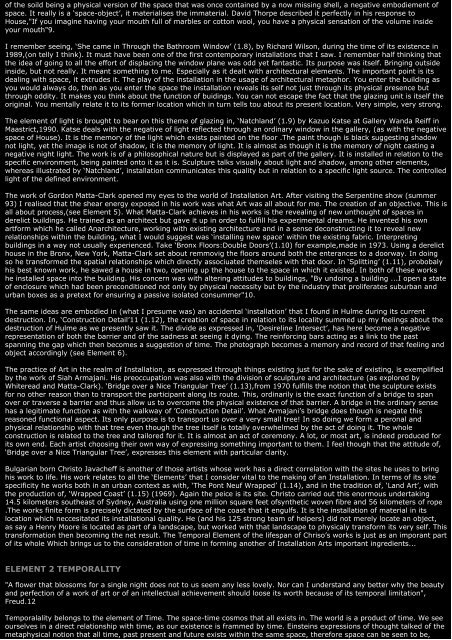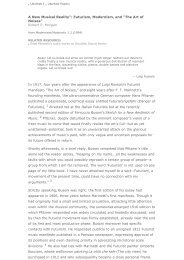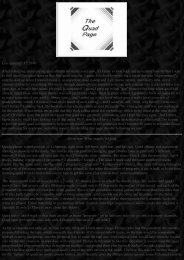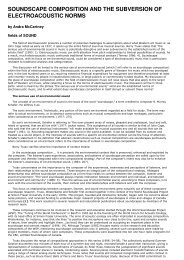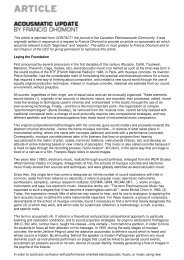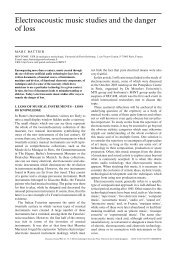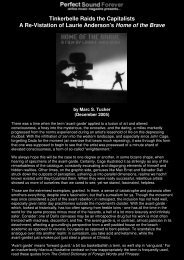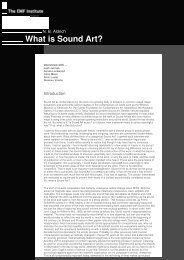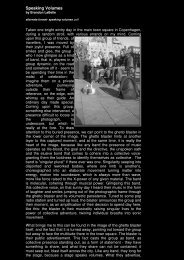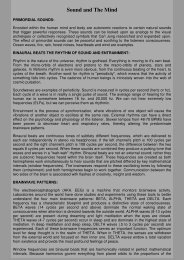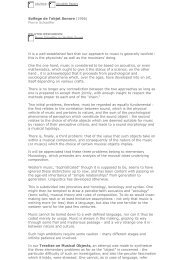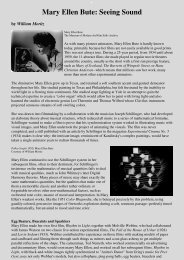Schaeffer_J-1994-6 Elements of Installation.pdf - An International ...
Schaeffer_J-1994-6 Elements of Installation.pdf - An International ...
Schaeffer_J-1994-6 Elements of Installation.pdf - An International ...
- No tags were found...
You also want an ePaper? Increase the reach of your titles
YUMPU automatically turns print PDFs into web optimized ePapers that Google loves.
<strong>of</strong> the soild being a physical version <strong>of</strong> the space that was once contained by a now missing shell, a negative embodiement <strong>of</strong>space. It really is a ‘space-object’, it materialises the immaterial. David Thorpe described it perfectly in his response toHouse,"If you imagine having your mouth full <strong>of</strong> marbles or cotton wool, you have a physical sensation <strong>of</strong> the volume insideyour mouth"9.I remember seeing, ‘She came in Through the Bathroom Window’ (1.8), by Richard Wilson, during the time <strong>of</strong> its existence in1989,(on telly I think). It must have been one <strong>of</strong> the first contemporary installations that I saw. I remember half thinking thatthe idea <strong>of</strong> going to all the effort <strong>of</strong> displacing the window plane was odd yet fantastic. Its purpose was itself. Bringing outsideinside, but not really. It meant something to me. Especially as it dealt with architectural elements. The important point is itsdealing with space, it extrudes it. The play <strong>of</strong> the installation in the usage <strong>of</strong> architectural metaphor. You enter the building asyou would always do, then as you enter the space the installation reveals its self not just through its physical presence butthrough oddity. It makes you think about the function <strong>of</strong> buidings. You can not escape the fact that the glazing unit is itself theoriginal. You mentally relate it to its former location which in turn tells tou about its present location. Very simple, very strong.The element <strong>of</strong> light is brought to bear on this theme <strong>of</strong> glazing in, ‘Natchland’ (1.9) by Kazuo Katse at Gallery Wanda Reiff inMaastrict,1990. Katse deals with the negative <strong>of</strong> light reflected through an ordinary window in the gallery, (as with the negativespace <strong>of</strong> House). It is the memory <strong>of</strong> the light which exists painted on the floor .The paint though is black suggesting shadownot light, yet the image is not <strong>of</strong> shadow, it is the memory <strong>of</strong> light. It is almost as though it is the memory <strong>of</strong> night casting anegative night light. The work is <strong>of</strong> a philosophical nature but is displayed as part <strong>of</strong> the gallery. It is installed in relation to thespecific environment, being painted onto it as it is. Sculpture talks visually about light and shadow, among other elements,whereas illustrated by ‘Natchland’, installation communicates this quality but in relation to a specific light source. The controlledlight <strong>of</strong> the defined environment.The work <strong>of</strong> Gordon Matta-Clark opened my eyes to the world <strong>of</strong> <strong>Installation</strong> Art. After visiting the Serpentine show (summer93) I realised that the shear energy exposed in his work was what Art was all about for me. The creation <strong>of</strong> an objective. This isall about process,(see Element 5). What Matta-Clark achieves in his works is the revealing <strong>of</strong> new unthought <strong>of</strong> spaces inderelict buildings. He trained as an architect but gave it up in order to fulfill his experimental dreams. He invented his ownartform which he called <strong>An</strong>architecture, working with existing architecture and in a sense deconstructing it to reveal newrelationships within the building, what I would suggest was ‘installing new space’ within the existing fabric. Interpretingbuildings in a way not usually experienced. Take ‘Bronx Floors:Double Doors’(1.10) for example,made in 1973. Using a derelicthouse in the Bronx, New York, Matta-Clark set about remmovig the floors around both the enterances to a doorway. In doingso he transformed the spatial relationships which directly associuated themseles with that door. In ‘Splitting’ (1.11), probobalyhis best known work, he sawed a house in two, opening up the house to the space in which it existed. In both <strong>of</strong> these workshe installed space into the building. His concern was with altering attitudes to buildings, "By undoing a building ...I open a state<strong>of</strong> enclosure which had been preconditioned not only by physical necessity but by the industry that proliferates suburban andurban boxes as a pretext for ensuring a passive isolated consummer"10.The same ideas are embodied in (what I presume was) an accidental ‘installation’ that I found in Hulme during its currentdestruction. In, ‘Construction Detail’11 (1.12), the creation <strong>of</strong> space in relation to its locality summed up my feelings about thedestruction <strong>of</strong> Hulme as we presently saw it. The divide as expressed in, ‘Desireline Intersect’, has here become a negativerepresentation <strong>of</strong> both the barrier and <strong>of</strong> the sadness at seeing it dying. The reinforcing bars acting as a link to the pastspanning the gap which then becomes a suggestion <strong>of</strong> time. The photograph becomes a memory and record <strong>of</strong> that feeling andobject accordingly (see Element 6).The practice <strong>of</strong> Art in the realm <strong>of</strong> <strong>Installation</strong>, as expressed through things existing just for the sake <strong>of</strong> existing, is exemplifiedby the work <strong>of</strong> Siah Armajani. His preoccupation was also with the division <strong>of</strong> sculpture and architecture (as explored byWhiteread and Matta-Clark). ‘Bridge over a Nice Triangular Tree’ (1.13),from 1970 fulfills the notion that the sculpture existsfor no other reason than to transport the participant along its route. This, ordinarily is the exact function <strong>of</strong> a bridge to spanover or traverse a barrier and thus allow us to overcome the physical existence <strong>of</strong> that barrier. A bridge in the ordinary sensehas a legitimate function as with the walkway <strong>of</strong> ’Construction Detail’. What Armajani’s bridge does though is negate thisreasoned functional aspect. Its only purpose is to transport us over a very small tree! In so doing we form a peronal andphysical relationship with that tree even though the tree itself is totally overwhelmed by the act <strong>of</strong> doing it. The wholeconstruction is related to the tree and tailored for it. It is almost an act <strong>of</strong> ceremony. A lot, or most art, is indeed produced forits own end. Each artist choosing their own way <strong>of</strong> expressing something important to them. I feel though that the attitude <strong>of</strong>,‘Bridge over a Nice Triangular Tree’, expresses this element with particular clarity.Bulgarian born Christo Javacheff is another <strong>of</strong> those artists whose work has a direct correlation with the sites he uses to bringhis work to life. His work relates to all the ‘<strong>Elements</strong>’ that I consider vital to the making <strong>of</strong> an <strong>Installation</strong>. In terms <strong>of</strong> its sitespecificity he works both in an urban context as with, ‘The Pont Neuf Wrapped’ (1.14), and in the tradition <strong>of</strong>, ‘Land Art’, withthe production <strong>of</strong>, ‘Wrapped Coast’ (1.15) (1969). Again the peice is its site. Christo carried out this enormous undertaking14.5 kilometers southeast <strong>of</strong> Sydney, Australia using one million square feet <strong>of</strong>synthetic woven fibre and 56 kilometers <strong>of</strong> rope.The works finite form is precisely dictated by the surface <strong>of</strong> the coast that it engulfs. It is the installation <strong>of</strong> material in itslocation which neccesitated its installational quality. He (and his 125 strong team <strong>of</strong> helpers) did not merely locate an object,as say a Henry Moore is located as part <strong>of</strong> a landscape, but worked with that landscape to physicaly transform its very self. Thistransformation then becoming the net result. The Temporal Element <strong>of</strong> the lifespan <strong>of</strong> Chriso’s works is just as an imporant part<strong>of</strong> its whole Which brings us to the consideration <strong>of</strong> time in forming another <strong>of</strong> <strong>Installation</strong> Arts important ingredients...ELEMENT 2 TEMPORALITY"A flower that blossoms for a single night does not to us seem any less lovely. Nor can I understand any better why the beautyand perfection <strong>of</strong> a work <strong>of</strong> art or <strong>of</strong> an intellectual achievement should loose its worth because <strong>of</strong> its temporal limitation",Freud.12Temporalality belongs to the element <strong>of</strong> Time. The space-time cosmos that all exists in. The world is a product <strong>of</strong> time. We seeourselves in a direct relationship with time, as our existence is frammed by time. Einsteins expressions <strong>of</strong> thought talked <strong>of</strong> themetaphysical notion that all time, past present and future exists within the same space, therefore space can be seen to be,


